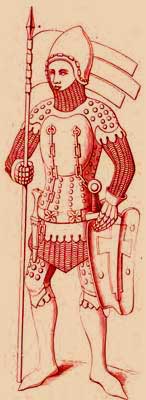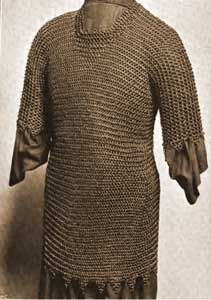Hauberk - The Main Body Armor of the Knight
The hauberk was the main part of the Medieval armor of the Norman Period. It was worn by the knights over the gambeson, a quilted garment which prevented the chain mail from bruising the body under the impact of a blow.

Plastron de Fer over Hauberk
Wood Carving, Bamberg Cathedral
The gambeson was worn also by the foot soldiers, but in their case, it was the sole defence. Looking at the Bayeux Tapestry, it appears that the defences of the leg, made of chain mail like the hauberk, were used at first only by the nobles.
The hauberk was the chief body defence. Its form, as shown on the Bayeux Tapestry, was that of a shirt. It was usually slit to the waist, front and back, for convenience on horseback, and the skirts reached to the knee, thus protecting the upper leg. The extreme weight of mail with its thick padded undergarment made the use of a horse a necessity. The weight was all borne upon the shoulders, and was not, as is the case with the plate armor, distributed over the limbs and body of the wearer.
The sleeves of the hauberk were sometimes short. The long sleeves could be of two varieties, one ending at the wrist, the other one ending in fingerless mittens of mail. The mittens could be turned back to leave the hand bare. The sleeve of the hauberk was sometimes secured at the wrist by a lace or strap.
At the beginning of the 13th century, the hauberk of chain mail was made with continuous coif and gloves. It was long, nearly to the knees, and at the face-opening left little more than the eyes and nose of the knight in view. The coif was flattened at the top of the head, and the gloves were still not divided into fingers. In the second half of the century the armourers were able to make a more flexible mail, and the gloves of the hauberk were divided for the fingers.
There was also a short version of the hauberk, named haubergeon. Wace, the chronicler, writing about Duke William at the Battle of Senlac, mentions a white shirt being seen beneath the hem of the haubergeon, which implies a much shorter length than that of the long-skirted version.
There are also mentions of the “plastron de fer”, a solid metal plate worn over the breast and sometimes at the back as well. It was put on either under or over the hauberk itself, usually beneath the jupon or surcoat, which at this period was the outermost garment worn. In either case it was not exposed to view. Wooden figures in Bamberg Cathedral, executed about 1370, show the exceptions, with the plastron de fer worn over the jupon, which seems to be studded with metal.
The hauberk survived well into the 14th century, and a close fitting Italian example is shown on the right. It is a single coat of mail with 10 inches long sleeves, with no slits, and no reinforcements. It is 2 feet 9 inches from the top of the collar, wider at the bottom then at the waist. The rings are of half-inch interior diameter. Half are riveted, made of circular wire. The rivets are pyramidal. The other half of the rings are continuous, having a pear-like form, with the rounded part on the inside circumference.
Round the neck, this hauberk has a row of brass rings, and the bottom of the edge and sleeves are finished by vandykes, also in brass rings, riveted with iron.


